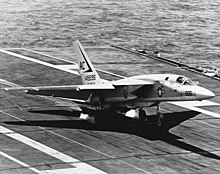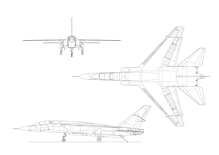North American A-5
| North American A-5 Vigilante | |
|---|---|
 An RA-5C of the US Navy RVAH-7 Reconnaissance and Assault Squadron |
|
| Type: |
Bomber (A-5A / B) reconnaissance aircraft (RA-5C) |
| Design country: | |
| Manufacturer: | |
| First flight: |
August 30, 1958 |
| Commissioning: |
June 1961 |
| Production time: |
1956 to 1963 |
| Number of pieces: |
158 |
The North American A-5 Vigilante ( lat. : The Watchful ) was a carrier based , supersonic speed all-weather bomber US Navy was that only a short time in his actual role in use, but has long been used as a reconnaissance.
development
The Ohio Division of North American Aviation began in November 1953 under the designation North American General Purpose Attack Weapon (NAGPAW) with the development of a carrier-based long - range bomber that could bring nuclear weapons to the target at supersonic speeds . After some changes in requirements by the Navy in January 1955 and the evaluation of a dummy in March 1956, North American received a letter of intent from the Navy on June 29, 1956 and a contract for the delivery of two prototype XA3J-1s was signed on August 29, 1956.
The rollout of the first prototype took place in mid-May 1958, and the first flight of the A-5 (still referred to as the A3J-1) was conducted by Richard Wenzel as a test pilot on August 31, 1958. On September 5, 1958, the machine reached supersonic speed for the first time. The first flight of the second prototype followed in November, but it crashed in June 1959 due to faults in the hydraulics and electrics. The contract for series production had already been signed in January 1959. Carrier tests aboard the USS Saratoga took place until July 1960 . During this time, an A-5 reached the world record height of 27,872 m on December 13, 1960 with a payload of 1000 kg. In June 1961 the first machines were put into service with the VAH-3 squadron , where they replaced the Douglas A-3 Skywarrior as a heavy bomber.
The improved A-5B was ordered in April 1962 and introduced in June 1962. It differed from the A version with a larger fuel supply in the enlarged back of the fuselage, inflated slats , larger flaps and four instead of two pylons under the wings. Only two machines of this version were delivered directly, four were used for retraining and the remaining twelve were immediately converted to RA-5C in the manufacturer's plant, with a side-view radar , an infrared sensor as well as various cameras and sensors and other devices being installed.
commitment

As part of the renaming of the aircraft of the US armed forces in 1962, the A3J-1 was renamed to A-5A , A3J-2 to A-5B and the later reconnaissance version from A3J-3P to RA-5C .
In addition to the problems with the advanced technology of the vigilante, there was a change in the US Navy's nuclear strategy. The focus was shifted from manned bombers launched from carriers to ballistic missiles launched from submarines . In 1963, all bombers (A-5A and A-5B) were decommissioned and converted into reconnaissance vehicles (RA-5C) and put back into service in July 1963. The squadrons have been renamed RVAH .
About Vietnam was RA-5C used more extensively for the first time in August 1964. The Vigilante flew numerous, partly very dangerous low altitude reconnaissance missions in which 18 aircraft were shot down by enemy air defenses. Other machines were lost in accidents, so that from 1968 to 1970 36 replacement machines were produced.
Although their use over Vietnam was successful, the maintenance costs and the complexity of the aircraft in operation exceeded the benefits, so that in 1974 decommissioning began. The last aircraft was decommissioned in September 1979.
construction
At the time of its introduction, the Vigilante was one of the largest and most complex aircraft deployed from aircraft carriers.
It had raised swept wings with blown flaps. The widely spaced General Electric J79 jet engines were also used in the F-4 Phantom , which was introduced around the same time . The crew (pilot, bombardier / navigator, later reconnaissance / navigator) sat behind each other in separate ejection seats .
For its size, the aircraft was extremely agile and manoeuvrable and, thanks to the powerful engines, had excellent climbing performance . Its high landing speed, however, often caused problems on the narrow carrier decks.
The Vigilante had very advanced electronics for its time, including one of the first fly-by-wire control systems, head-up displays and one of the first on-board computers ( VERDAN = " Ver satile D igital An alyzer"), but one of the many Suffered problems. The average time between failures was 15 minutes, which made the machine extremely unreliable, especially at the beginning of its service life. The complex electronics made the A-5 a nightmare for the maintenance technician as well.
The aircraft had two underwing stations that were intended for additional tanks . The main armament was a single atomic bomb (usually Mk28 ), which was housed in a shaft between the engines. Together with two then empty fuel tanks , which were also in the shaft, this should then be ejected at the target. However, this system was very imprecise and, on top of that, unreliable, problems often arose, among other things, when the catapult was launched, the tanks and sometimes the live nuclear weapon fell onto the deck of the carrier. In the reconnaissance variant, the shaft was only used for fuel, but even that was never entirely problem-free.
The RA-5C had slightly larger wings than the bomber and carried a cover under the fuselage in which various reconnaissance equipment was housed, including an APD-7 side-looking airborne radar , an AAS-21 infrared scanner and several Cameras. It kept its weapon bay , so theoretically it could still be used for attacks. The machines built later received somewhat more powerful engines with 80 kilonewtons of thrust.
Versions
NA-233 Nagpaw
Early concept of a low-level attack aircraft.
NA-247 / YA3J-1
Prototypes (2 machines)
- Bu.No. 145157, 145158 c / n 247-1 & 2
NA-247 / A3J-1
Early production variant of the bomber version.
- Bu.No. 146694 - 146702 c / n 247-3 - 11 (9 pieces)
- Bu.No. 146703 - 146708, the order has been withdrawn.
NA-263 / A3J-1 later A-5A
- Bu.No. 147850 - 147863 c / n 263-1 - 14 (14 pieces)
NA-269 / A3J-1 later A-5A
- Bu.No. 148924 - 148933 c / n 269-1 - 10 (10 pieces)
- Bu.No. 149276 - 149299 c / n 269-11 - 34 (24 pieces)
43 of the A3J-1 (A-5A) were later converted to A3J-3P (RA-5C).
NA-269 / A3J-2 later A-5B
Later bomber variant
- Bu.No. 149 300 - 149 305 c / n 269 - 35 - 40 (6 pieces)
NA-269, 279, 283 / A3J-3P later RA-5C
Long-range photo reconnaissance aircraft
- Bu.No. 149306 - 149317 c / n 269-41 - 52 (12 pieces)
- Bu.No. 150823 - 150842 c / n 279-1 - 20 (20 pieces)
- Bu.No. 151615 - 151634 c / n 283-21 - 40 (20 pieces)
- Bu.No. 151726 - 151728 c / n 283-41 - 43 (3 pieces)
Plus 43 converted A-5A
NR-349 retaliator
The NR-349 Retaliator was North American's proposal for a high-performance fighter aircraft for the US Air Force as a variant of the A-5 with three engines. A third General Electric J79 was in the shaft between the other two engines with two narrow air inlets offset backwards above the inlets of the other engines. The aircraft was to be armed with six AIM-54 Phoenix at sub-fuselage stations. Since no development order followed, plans, drawings and models remained.
Technical specifications
| Parameter | RA-5C data |
|---|---|
| crew | 2 |
| length | 23.11 m |
| Wingspan | 16.15 m |
| Wing area | 70.05 m² |
| Wing extension | 3.72 |
| Wing loading |
|
| height | 5.92 m |
| Empty mass | 17,009 kg |
| normal takeoff mass | 28,580 kg |
| maximum take-off mass | 36,285 kg |
| Fuel capacity | 13,730 kg (internal) |
| Top speed | Mach 2.1 or 2.230 km / h (with afterburner at optimal altitude) |
| Service ceiling | 20,400 m |
| Use radius | 2,075 km (with additional tanks) |
| Transfer range | 5,015 km (with additional tanks) |
| Armament | no |
| Engine | two General Electric J79 -GE-10- turbojets with 79.47 kN each |
| Thrust-to-weight ratio |
|
See also
literature
- Heiko Müller: A career with detours - the Vigilante contained more new technologies than any other aircraft of its time. in: Flug Revue Edition Klassiker der Luftfahrt 2/05 , pp. 46–51
- Robert R. Powell: RA-5C Vigilante Units in Combat . Osprey Publishing, London 2004. ISBN 1-84176-749-2
Web links
- North American A-5 Vigilante by Greg Goebel (English)
- Detailed views of a model of the NR-349 Retaliator project
Individual evidence
- ↑ a b c FliegerRevue July 2013, pp. 52–55, North American A-5 Vigilante - ahead of its time
- ↑ Joseph F. Baugher: North American A3J-1 Vigilante
- ^ Bill Yenne: The Story of the Boeing Company . Zenith Imprint, 2005, ISBN 0-7603-2333-X , p. 108 ( limited preview in Google Book search).
- ↑ Jay Miller, Michael Grove: North American Rockwell A3J / A-5 Vigilante. Aerofax Minigraph, ISBN 0-942548-14-0 , ISBN 978-0-942548-14-3







